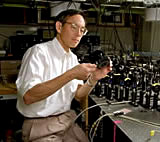Steve Chu

Nobel Prize Laureate
If you ever get the feeling that life is a blur, maybe it’s because the atoms that make up the world around us are always moving at speeds faster than those of supersonic jet planes (about 4,000 kilometers per hour). By cooling an atom down to a temperature of nearly absolute zero (-273 degrees Celsius), you can slow its movement to a crawl and then use light to trap and manipulate it. That’s what physicist Steven Chu, the new director of Berkeley Lab, did to win a share of the 1997 Nobel Prize in physics.
Arthur Ashkin at Bell Labs started me thinking about holding onto an atom with light back in 1983,” Chu said in an earlier interview. “The conventional wisdom at that time was first you hold the atom with light and then you make it cold so you can do what you want with it. My idea was to reverse this by cooling the atom first, then grabbing it with light.”
In 1985, Chu and his team at Bell Laboratories in Holmdel, N.J., used six laser beams, opposed in pairs and arranged in three directions at right angles to one another, to create what he called “optical molasses.” While photons in a laser beam have no mass, they do have momentum. If the energy of a moving photon resonates with the energy of a moving atom at the time a collision occurs, the photon will transfer its momentum to the atom, giving it a push in the direction at which the photon was moving.
Working in a vacuum to avoid freezing the atoms into a solid state, Chu and his team hit a beam of sodium atoms with an opposing beam of laser light. This slowed the atoms down and allowed them to be steered into an intersection where the six cooling laser beams met. Atoms caught in the laser crossfire had nowhere to go without being hit by another beam and pushed back to the center of the intersection. A glowing cloud about the size of a pea formed, containing about a million super-chilled sodium atoms.
“Atoms in the optical molasses take what is called a random walk — moving around aimlessly as they’re hit from all sides by photons,” Chu once said. “The trap is a tempting resting place.”
Chu and his team were able to cool the atoms to 240 millionths of a degree above absolute zero. Subsequent work by American physicist William Phillips and French physicist Claude Cohen-Tannoudji, who shared the Nobel Prize with Chu, brought the temperature down to one micro-Kelvin, or one millionth of a degree above absolute zero.
Caught in optical traps at such low temperatures, atoms can be studied in great detail to help us learn more about such things as the interplay between radiation and matter. The traps can also be used to create an atom interferometer for measuring acceleration, gravity and rotations with very high accuracy. The optical molasses technique also led to the discovery of the esoteric form of matter known as a Bose-Einstein condensate.
Said Chu when he won the Nobel Prize, “It’s remarkable what simple curiosity can lead to.”









